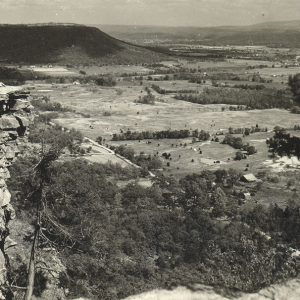calsfoundation@cals.org
Tintop (Scott County)
Tintop (sometimes rendered Tin Top) is an unincorporated community located in southwestern Scott County. Tintop was established in 1904 at the base of Horseshoe Mountain between Dry Creek and Clear Fork Creek. Agriculture and timber have contributed to the economy and way of life in the area.
Prior to European exploration, the area surrounding Tintop was a wilderness. Several species of wildlife that no longer inhabit the area, such as elk and buffalo, were present throughout the region. Numerous archaeological sites and burial mounds are located along the banks of prominent waterways such as the Fourche La Fave and Poteau rivers. Archaeological findings have provided evidence of early inhabitants dating to the Archaic, Woodland, and Mississippian periods. Further archaeological evidence has indicated that the people of the Caddo tribe later inhabited the area.
During the late seventeenth and early eighteenth centuries, French hunters and tradesmen traveled west from the Arkansas Post, exploring portions of western Arkansas. These Frenchmen often traversed rivers and streams throughout the region. Several rivers that flow through Scott County were likely named by these explorers, including the Petit Jean, Poteau, and Fourche La Fave. It is probable that the explorers traveled along the Fourche La Fave River or Clear Fork Creek near present-day Tintop.
Settlers began arriving in the area around Tintop in the 1870s. Some of the area’s earliest settlers included the Slover, Atterberry, Rambo, Evatt, Livesay, and Nevill families. The area was settled throughout the early twentieth century.
Men called to fight in the Civil War served with both the Confederacy and Union. The women, children, and elderly were left to look after family homes and farms.
After the Civil War, there was a large migration into western Scott County. The first cemetery to be established near Tintop was Johnson Cemetery in 1873. Slover Cemetery is an additional burial ground in Tintop. It is unclear as to when Slover Cemetery was established, as there are only two marked graves in the cemetery among a bed of fieldstone graves. The cemetery was named for the Slover family who settled in the area and likely donated the land for the burial ground.
In May 1904, Warren L. Leamon and forty-six others petitioned the county court for a new school district. The court granted the proposal and created Tintop School District (Number 77). Tintop’s name is possibly derived from the school house or other prominent building that had a tin roof.
The Ritz Post Office served the community of Tintop. The post office was established in 1914, with William H. Ritz as the first postmaster. It was discontinued in 1937 and the mail sent to Polk County.
The Tintop School District was consolidated with Robson (Scott County) sometime between 1930 and 1940. Robson was consolidated with Boles in 1941.
Agriculture continues to be a prominent way of life in the area, mostly in the form of cattle and chicken farms. Timber is logged throughout the Ouachita National Forest in the surrounding area.
For additional information:
Cate, Michael. History of Scott County, Arkansas. Dallas, TX: Curtis Media Corporation, 1991.
Echoes: The Scott County Historical and Genealogical Society Quarterly. Waldron, AR: Scott County Historical and Genealogical Society (1986–).
Goodner, Charles. Scott County in Retrospect. Mansfield, AR: Frank Boyd, 1976.
Goodner, Norman. A History of Scott County, Arkansas. Siloam Springs, AR: Bar D Press, 1941.
McCutcheon, Henry Grady. History of Scott County, Arkansas. Little Rock: H. G. Pugh and Company, 1922.
Ty Richardson
Richardson Preservation Consulting
 Clear Fork Creek
Clear Fork Creek  Horseshoe Mountain
Horseshoe Mountain  Johnson Cemetery
Johnson Cemetery  Scott County Map
Scott County Map  Tintop: North
Tintop: North  Tintop: South
Tintop: South 



Comments
No comments on this entry yet.